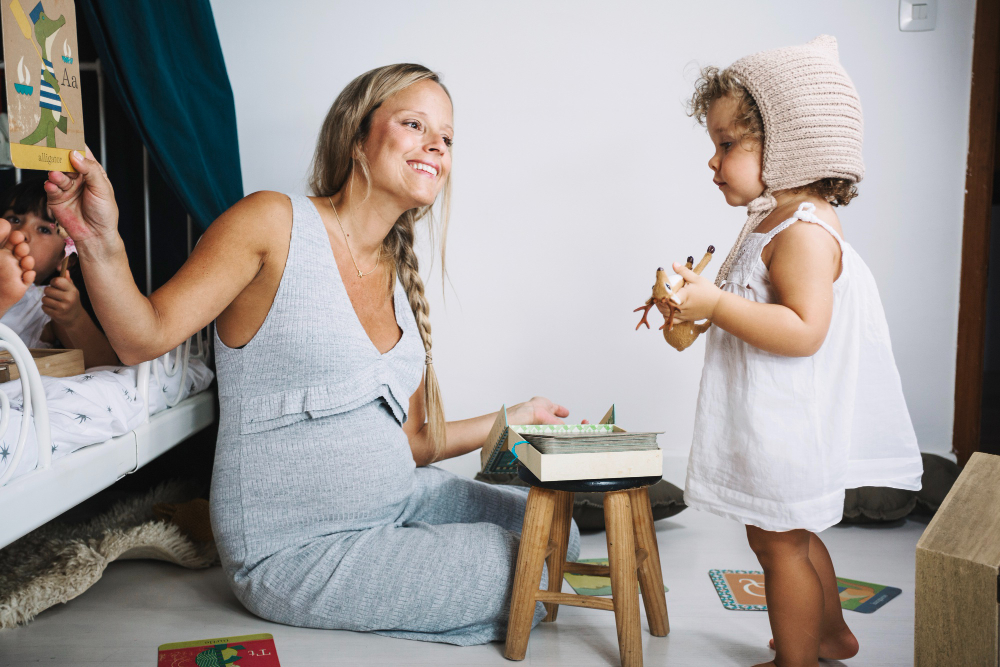Discover what the Montessori Method is, who Maria Montessori was, and how this 100-year-old approach still helps toddlers thrive today.
Disclaimer: At Wonderly Made, we are committed to providing honest and unbiased product reviews to help parents make informed decisions.
Wonderly Made is a participant in the Amazon Services LLC Associates Program, an affiliate advertising program designed to provide a means for us to earn fees by linking to Amazon.com and affiliated sites. This means that when you purchase through links on our site, we may earn a small commission at no extra cost to you.
We only recommend products we genuinely love.
Let’s talk about the Montessori Method. If you’ve ever looked up “toys that don’t make noise or light up” or “how to get my toddler to focus for more than 30 seconds,” chances are you’ve stumbled into the magical, wooden-toy-filled world of Montessori. And honestly? There’s a reason moms are still talking about it over a century later.
But what is the Montessori Method really? Is it just neutral-colored toys and toy rotation bins? Not exactly. There’s so much more to it and, yes, it actually makes sense for real-life families, even if you’re not living in an Instagram-perfect playroom.

Who Was Maria Montessori?
Maria Montessori was an Italian physician and educator (yes, a woman doctor in the late 1800s) who believed that children weren’t just tiny people to mold but individuals who learn naturally through exploration and independence. She opened her first classroom in 1907 and called it the Casa dei Bambini, or “Children’s House.”
What she saw was kind of amazing: when kids were given the right environment, calm, orderly, and filled with materials made just for them- they didn’t just learn. They thrived.
Her philosophy caught on fast. And now, more than 100 years later, her method is used around the world in schools, homes, and even toy aisles at Target.
So What Is the Montessori Method?
In a nutshell, Montessori is all about encouraging kids to be independent, self-motivated, and deeply curious. It’s a hands-on, child-led approach to learning where the adult is more of a guide than a lecturer.
Here are some key ideas:
- “Help me do it myself” is a core principle
- The environment matters: things are kept clean, simple, and within the child’s reach
- Children move at their own pace
- Learning comes from doing, not just listening
- Respect for the child is everything
There’s a lot of structure behind the simplicity. It’s not just about wooden toys and quiet spaces, it’s about believing that children, even the tiniest ones, are capable and full of potential.
Why Moms Love It
Let’s be honest. One reason the Montessori Method is still trending is because it actually works. It helps kids build confidence and independence, and it gives moms some structure that doesn’t involve constant entertainment or overstimulation. It’s about quality over quantity – less stuff, more meaning. And yes, it’s also aesthetically pleasing (neutral toy bins and all).
But the real reason moms keep coming back to Montessori? It’s respectful. It trusts the child. And when you trust your toddler, they surprise you with what they can actually do.

What Does That Look Like at Home?
You don’t need to enroll in a Montessori school (or sell a kidney to afford one) to use this method. It’s absolutely possible to bring Montessori into your home in small, practical ways.
-
Toys: Simple, open-ended toys made from natural materials (wood, fabric, metal). You can find suggestions on Montessori inspired toys Here
-
Routines: Giving toddlers small responsibilities, like pouring their own water or putting their shoes on
-
Shelves: Keeping toys accessible and organized so they can choose what they want to explore. You can find the guide to creating a Montessori inspired Room Here
-
Words: Using respectful, clear language with your child even if they’re still learning to speak
-
Pace: Slowing down and letting your child take the lead sometimes (even if it means watching them “zip” their coat for 6 minutes)
So Why Are Montessori Schools So Expensive? Here’s the Honest Truth
If you’ve ever looked into Montessori schools and then quietly gasped at the tuition, you’re not alone. I’ve been there, googling Montessori programs, getting inspired by the philosophy, dreaming of peaceful classrooms filled with wooden materials and calm children who joyfully clean up after themselves… and then bam – sticker shock.
So let’s break it down: why are Montessori schools so expensive? Are they just charging for the neutral wood shelves and tiny brooms? Or is there more behind that price tag?
1. The Teachers Are Highly Trained
Montessori teachers (called “guides”) don’t just go through standard teacher certification. They complete specialized Montessori training programs that can take a year or more, and they often pay out of pocket for it. These programs dive deep into child development, philosophy, classroom design, and how to observe and guide a child without interfering.
That level of expertise doesn’t come cheap. And rightfully so, they’re doing important work, and their training is what sets the Montessori approach apart.
2. Low Student-to-Teacher Ratios
Montessori classrooms usually have fewer students per teacher compared to traditional schools. This allows teachers to focus on each child’s individual needs, follow their pace, and foster true independence.
But fewer students per class means schools make less money per classroom and tuition has to make up the difference.
3. The Materials Aren’t Just Pretty – They’re Purposeful
Those wooden trays and bead chains? They’re not just there to look natural and minimalist. Montessori materials are very specific, often imported, and designed with precision for hands-on, self-correcting learning.
Each material serves a developmental purpose and many are durable, heirloom-quality pieces that cost more than your average plastic toy. Multiply that by a whole classroom set, and you’ve got a serious investment.
4. Classrooms Are Set Up Like Mini Learning Worlds
Montessori classrooms are beautifully organized, calm, and child-centered. Everything is tailored to the child’s height, ability, and independence including furniture, shelves, tools, and even cleaning supplies.
Setting up and maintaining this kind of environment is expensive. It’s not just buying supplies, it’s designing a space that supports developmental psychology in action.
5. Most Montessori Schools Are Private and Unsubsidized
Many Montessori schools aren’t part of the public school system, which means they don’t receive government funding. That makes them 100% dependent on tuition to cover everything: salaries, rent, materials, meals, maintenance, insurance – you name it.
Unlike public schools that get federal or state dollars, private Montessori schools have to pay their own way and that cost is passed on to families.
6. Montessori Doesn’t Do Standardized, One-Size-Fits-All Anything
Montessori education is about following the child, not following a district’s pacing guide. That means lesson plans are tailored, progress is observed (not graded), and teachers invest more time per student.
It’s individualized. It’s slow. It’s intentional. And it requires more resources, time, and effort than traditional schooling methods because Montessori is about depth, not shortcuts.
So… Is It Worth It?
That’s the question only you can answer. Montessori isn’t about prestige. It’s not about fancy. It’s about a child-led approach that fosters independence, confidence, empathy, and a lifelong love of learning.
And while the tuition can feel daunting, some families find it’s worth every penny for the long-term benefits in their child’s development and emotional well-being.
But here’s the good news: you don’t have to pay private school tuition to embrace Montessori at home. You can bring the method into your life through your routines, your mindset, your toy choices, and your approach to parenting. The heart of Montessori doesn’t live in the classroom – it starts with respect, patience, and a belief in your child’s ability to grow and learn.
And that? That costs nothing at all.

